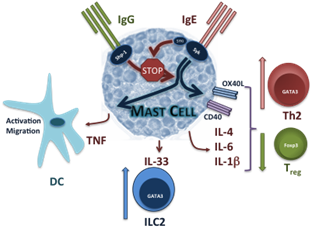Research Focus: Mechanisms of Immune Sensitization and Inhibition in Food Allergy
Treatments to prevent or eliminate food allergy are virtually non-existent. The Oettgen lab uses novel mouse models and clinical studies of food-allergic patients to delineate mechanisms leading to allergic sensitization to ingested antigens as well as regulatory pathways promoting tolerance. In collaboration with Dr. Talal Chatila, also in the Division of Immunology at Boston Children's Hospital, we have developed a mouse model of food allergy that provides an ideal tool for such mechanistic analyses. We have found that IL4raF709 mice, which have an activated variant of the IL-4 receptor, can be sensitized to the natural food allergen, peanut, by ingestion (without priming or adjuvants) and exhibit strong IgE-mediated anaphylactic responses upon challenge. Using these animals, we've established that IgE-activated mast cells serve not only to release the mediators responsible for anaphylactic reactions but also play a critical regulatory role in adaptive immune responses; suppressing the induction of effective peanut-specific Treg cells and promoting the emergence of pro-allergic Th2 cells. IgE blockade with antibodies or pharmacologic inhibition of FceRI signaling during peanut sensitization in this model led to the emergence of an effective Treg response to peanuts and failure to develop food allergy. Strikingly, inhibition of the IgE:mast cell axis in animals with established allergy was effective in eliminating Th2 responses; inducing Treg and essentially curing food allergy.
Using both the mouse model and human studies of oral immunotherapy (OIT) to peanut we have also recently shown that food allergen ingestion leads to the induction of IgG antibodies that signal via the inhibitory IgG receptor, FcyRIIb, on mast cells and basophils to prevent IgE-mediated activation. We believe this inhibitory IgG mechanism is important in both OIT and in the natural resolution of sensitivity in children outgrowing their food allergies.
Our current studies are focused on identifying key checkpoints in IgE and IgG responses in food allergy and on developing innovative strategies to mediate them.
